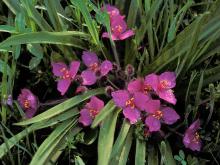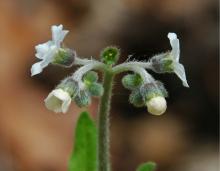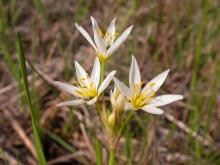Wildflowers, Grasses and Other Nonwoody Plants
Media
Species Types
Scientific Name
Anagallis arvensis (Lysamachia arvensis)
Description
The scarlet pimpernel, a native of Europe, is a tender annual with scarlet or brick-red flowers that close around 4 p.m., or whenever clouds shade the sun. When the sun comes out again, they reopen.
Media

Species Types
Scientific Name
Persicaria amphibia (formerly Polygonum amphibium)
Description
Water smartweed can live submerged in water, or on wet banks or other soggy ground, yet it can also live in merely moist areas. The stems often sprawl as they grow, taking root at the swollen nodes. The small, pink flowers develop in long, erect clusters.
Media

Species Types
Scientific Name
Nasturtium officinale (syn. Rorippa nasturtium-aquaticum)
Description
Spring branches and streams in the Ozarks are decorated with large colonies of these plants, which can grow like thick green garlands in the water. It has a long history of use as a salad green, and it is cultivated to sell to gourmet cooks. If you collect watercress from the wild, make sure to wash it thoroughly.
Media

Species Types
Scientific Name
All true grasses (species in the grass family)
Description
Missouri has 276 species in the grass family, including well-known crop plants and our native prairie grasses. Distinguishing between the species can be difficult, but it’s easy to learn some basics about the group.
Media

Species Types
Scientific Name
Calystegia sepium (also Convolvulus sepium)
Description
Instantly recognizable as a type of morning glory, hedge bindweed is common in disturbed habitats and can be a serious agricultural weed, but it is not as problematic as its relative field bindweed.
Media

Species Types
Scientific Name
Tradescantia longipes
Description
Dwarf spiderwort is a low-growing perennial with bright magenta, purple, or purplish-blue flowers with three petals arranged in a triangular pattern. It blooms in Ozark woodlands in April and May.
Media

Species Types
Scientific Name
Cynoglossum virginianum
Description
Wild comfrey has large basal leaves that are soft, hairy, and elliptical with long petioles — they look like hounds’ tongues! The upright flowering stalk has few leaves and looks like a wand.
Media

Species Types
Scientific Name
Nothoscordum bivalve
Description
False garlic looks like a wild garlic or onion plant, but it doesn’t smell like one. The flowers can be white, yellowish, or greenish, and they appear in spring and sometimes also fall.
Media

Species Types
Scientific Name
Antennaria parlinii
Description
Plainleaf pussytoes, named for its fuzzy flower heads, is one of the few flowering plants in Missouri that grows well in dry and shaded areas. It’s also an indicator of acid soils.
Media

Species Types
Scientific Name
Comandra umbellata (formerly C. richardsiana)
Description
Bastard, or false toadflax is one of the hundreds of wildflowers that bejewel our native prairies. A perennial herb with yellowish-green foliage and smooth, upright stems, it grows and flowers under the hottest conditions.
See Also
About Wildflowers, Grasses and Other Nonwoody Plants in Missouri
A very simple way of thinking about the green world is to divide the vascular plants into two groups: woody and nonwoody (or herbaceous). But this is an artificial division; many plant families include some species that are woody and some that are not. The diversity of nonwoody vascular plants is staggering! Think of all the ferns, grasses, sedges, lilies, peas, sunflowers, nightshades, milkweeds, mustards, mints, and mallows — weeds and wildflowers — and many more!





















